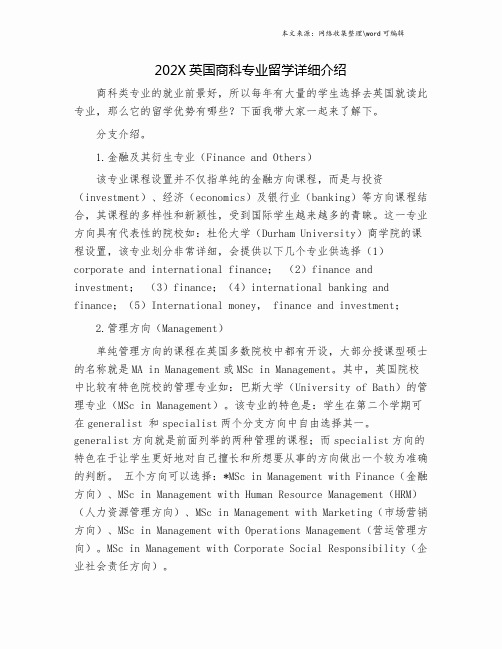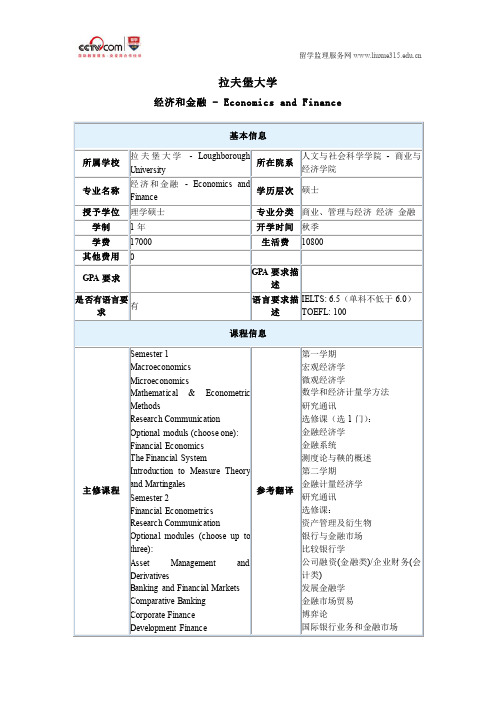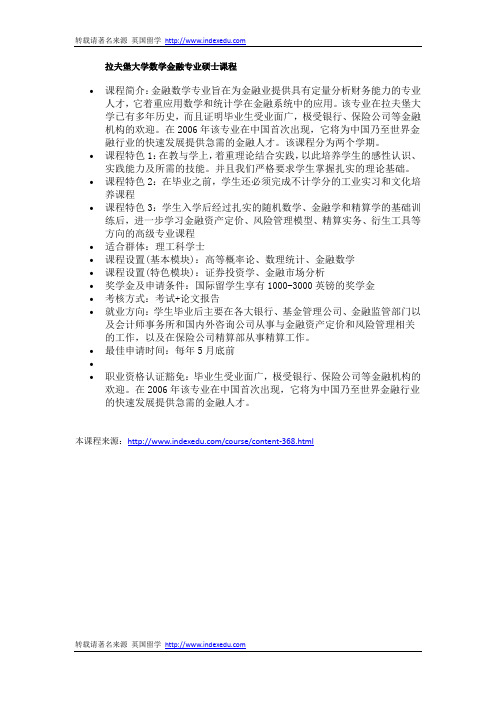202X年英国拉夫堡大学金融专业课程.doc
- 格式:doc
- 大小:14.00 KB
- 文档页数:3

202X英国商科专业留学详细介绍商科类专业的就业前景好,所以每年有大量的学生选择去英国就读此专业,那么它的留学优势有哪些?下面我带大家一起来了解下。
分支介绍。
1.金融及其衍生专业(Finance and Others)该专业课程设置并不仅指单纯的金融方向课程,而是与投资(investment)、经济(economics)及银行业(banking)等方向课程结合,其课程的多样性和新颖性,受到国际学生越来越多的青睐。
这一专业方向具有代表性的院校如:杜伦大学(Durham University)商学院的课程设置,该专业划分非常详细,会提供以下几个专业供选择(1)corporate and international finance;(2)finance and investment;(3)finance;(4)international banking and finance;(5)International money, finance and investment;2.管理方向(Management)单纯管理方向的课程在英国多数院校中都有开设,大部分授课型硕士的名称就是MA in Management或MSc in Management。
其中,英国院校中比较有特色院校的管理专业如:巴斯大学(University of Bath)的管理专业(MSc in Management)。
该专业的特色是:学生在第二个学期可在generalist 和specialist两个分支方向中自由选择其一。
generalist方向就是前面列举的两种管理的课程;而specialist方向的特色在于让学生更好地对自己擅长和所想要从事的方向做出一个较为准确的判断。
五个方向可以选择:*MSc in Management with Finance(金融方向)、MSc in Management with Human Resource Management(HRM)(人力资源管理方向)、MSc in Management with Marketing(市场营销方向)、MSc in Management with Operations Management(营运管理方向)。

国外金融专业课程的内容主要包括以下几个方面:
金融市场和金融机构:介绍金融市场和金融机构的基本概念、运作原理和风险管理等。
投资学:介绍投资的基本原理、投资组合理论、资本资产定价模型、期权定价模型等。
公司金融:介绍公司金融的基本概念、公司财务报表分析、资本预算、风险管理等。
金融衍生品:介绍期货、期权、互换等金融衍生品的基本概念和交易策略。
宏观经济和政策:介绍宏观经济的基本概念、货币政策和财政政策、通货膨胀和失业等。
金融风险管理:介绍金融风险管理的基本概念、方法和工具,包括信用风险、市场风险和操作风险等。
计量经济学和统计方法:介绍计量经济学和统计方法在金融领域中的应用,如时间序列分析、回归分析等。

金融学大一到大四课表大一课表:
1. 微观经济学
2. 宏观经济学
3. 数学分析
4. 线性代数
5. 金融市场与金融机构
6. 会计学基础
7. 统计学基础
8. 金融数学
9. 应用统计学
10. 金融风险管理
大二课表:
1. 金融学原理
2. 金融工程学
3. 金融市场分析
4. 金融会计
5. 银行学
6. 投资学
7. 金融数据分析
8. 金融模型与计算
9. 金融工具与衍生品
10. 金融市场与投资分析
大三课表:
1. 金融风险管理
2. 金融市场与机构
3. 金融工程与金融创新
4. 金融市场调查与分析
5. 国际金融
6. 金融市场与投资银行
7. 金融计量经济学
8. 金融决策模型
9. 金融市场与行为经济学
10. 金融风险与金融监管
大四课表:
1. 金融市场与投资策略
2. 金融创新与创业
3. 金融研究方法
4. 金融企业管理
5. 金融实务与综合案例分析
6. 金融学毕业论文
7. 金融实习
8. 金融市场与金融法律
9. 金融资产定价与投资组合管理。


英国拉夫堡大学银行与金融专业简介及入学要求
学校名称:英国拉夫堡大学 Loughborough University
所在位置:英国
学费:14300-18250英镑/学年
录取率:0.2
拉夫堡大学 (University of Loughborough)
专业名称:银行与金融MSc Banking and Finance
专业介绍及优势
1、为想在工业和政府的金融领域,特别是中央银行和银行内的人员进入更高一级的研究和培训所设立的基本培训;课程不仅仅包括银行,金融方面的培训,同时在宏观经济和微观经济领域也进一步做出专业的研究;
2、可以使学员在经济,银行和金融系统掌握更多的专业技能,使学员得到最大的发展;
3、重视研究,每年只招收120名左右的1年制硕士;学院为理学硕士提供各种经济学、金融方面的研究训练途径,包括有模拟屏的金融工具交易;
4、毕业生就业面很广。
学院配有专业电脑实验室,使学生可以进行经济软件以及相关工商业类软件的实际操作,使学生的发展更适合于目前倾向于电脑应用人才的用人市场。
学生在这里可以学到商业、金融、货币、政府政策和全球经济的专业知识。
掌握工业、组织、以及整个经济系统的构建和经济市场实际的价值评估。
入学要求
大学本科学位,英国二等学位以上,平均成绩75%以上;有金融,经济,银行专业背景;雅思6.5 单科不得低于6.0
学费:£14,900/学年
开学时间:9月。

转载请著名来源英国留学拉夫堡大学数学金融专业硕士课程∙课程简介:金融数学专业旨在为金融业提供具有定量分析财务能力的专业人才,它着重应用数学和统计学在金融系统中的应用。
该专业在拉夫堡大学已有多年历史,而且证明毕业生受业面广,极受银行、保险公司等金融机构的欢迎。
在2006年该专业在中国首次出现,它将为中国乃至世界金融行业的快速发展提供急需的金融人才。
该课程分为两个学期。
∙课程特色1:在教与学上,着重理论结合实践,以此培养学生的感性认识、实践能力及所需的技能。
并且我们严格要求学生掌握扎实的理论基础。
∙课程特色2:在毕业之前,学生还必须完成不计学分的工业实习和文化培养课程∙课程特色3:学生入学后经过扎实的随机数学、金融学和精算学的基础训练后,进一步学习金融资产定价、风险管理模型、精算实务、衍生工具等方向的高级专业课程∙适合群体:理工科学士∙课程设置(基本模块):高等概率论、数理统计、金融数学∙课程设置(特色模块):证券投资学、金融市场分析∙奖学金及申请条件:国际留学生享有1000-3000英镑的奖学金∙考核方式:考试+论文报告∙就业方向:学生毕业后主要在各大银行、基金管理公司、金融监管部门以及会计师事务所和国内外咨询公司从事与金融资产定价和风险管理相关的工作,以及在保险公司精算部从事精算工作。
∙最佳申请时间:每年5月底前∙∙职业资格认证豁免:毕业生受业面广,极受银行、保险公司等金融机构的欢迎。
在2006年该专业在中国首次出现,它将为中国乃至世界金融行业的快速发展提供急需的金融人才。
本课程来源:/course/content-368.html转载请著名来源英国留学。
英国拉夫堡大学金融管理专业的最新介绍学校名称:英国拉夫堡大学 Loughborough University所在位置:英国学费:14300-18250英镑/学年录取率:0.2拉夫堡大学的金融管理专业如何?下面86店铺就为大家介绍一下。
在中国留学生最欢迎的英国研究生课程中,金融专业的比例远远超过其它课程。
英国的金融专业设置通常较为实用,大多是与财会、经济或投资相结合的。
拉夫堡大学官方网站对金融管理课程的介绍中提到,此课程是为非金融专业背景、希望从事金融管理方向的申请者设置的。
因此,比较适合转专业的同学。
介绍中还提到,通过一年的课程学习,加上团队合作项目,以及相关案例的研究实践,不但可以增长商科相关的知识和技能,还能加强自身的竞争能力。
在2008年英国高等学校的科研评估(Research Assessment Exercise,RAE)中,拉夫堡大学在总排名的第37位,在商业与管理这个领域工作中,有15%处于4*;45%处于3*。
金融管理专业是在拉夫堡大学的商业与管理的系别里的。
而一个大学的研究工作,在4*中占的比例越大,这个大学在这一专业或领域的研究实力就越强。
就数据来看,跟拉夫堡大学的其它专业相比,金融管理不是这所大学的强项。
和英国其它大学的同等专业相比,拉夫堡大学的金融管理也处于中等水平。
近日,教育部公布了最新版正规海外院校名单拉夫堡大学是名列在内的,所以回国当然也是被认可的。
由英国高等教育统计署(Higher Education Statistics Agency –HESA)提供的英国大学就业率(Graduate prospects)数据来看,拉夫堡大学的就业率为72.1%,在116所大学中排名第26。
不过,学校排名、一系列的数据是一回事,自己怎么学是另一回事。
同一门课,老师推荐参考书了,那么自觉跑图书馆,参考书读得更多的,自然比只上课的学得多。
学到多少,靠自己。
是否应该选择一所学校,除了名次,更要看这个课程是否适合你,是否适合你未来的发展方向,建议多做调查工作,多比较,不要因为网上的随便几句答复,就定下自己未来的归宿。
《货币金融学》课程教学大纲(Syllabus of the course of moneyand Finance)Previously, I was looking at other uploaded documents. This time, I uploaded some documents to share with you!Syllabus of the course of money and FinanceNumber: 40064040English Name: Money and FinanceApplicable major: accounting, financial managementResponsible teaching unit: Department of economics and managementTotal hours: 64Examination form: ExaminationClass: Basic CoursesWay to read: requiredThe nature, position and function of curriculum: finance is the basic course or optional course for undergraduates majoring in finance, economics and managementFinance studies not only the general laws of money, credit, and banking activitiesModern financial and economic operations in general form, norms, principles and proceduresIts content is both macroscopic, comprehensive and strategicIt also has the characteristics of micro, individual, strategic and applicableTherefore, this course is not only the concrete and deepening of political economy and macroeconomics, but also MicroeconomicsIt is the generalization and sublimation of the financial and economic laws, operating rules and operating methodsBy studying the courseTrain the students' basic knowledge of Finance and their ability of research and ApplicationTo provide theoretical knowledge and research ideas for the follow-up coursesTeaching purpose: study through this courseStudents are required to master the basic theories, basic knowledge and basic methods of monetary finance in a more comprehensive wayRecognize the rules of money, credit, financial markets, andbank activitiesUnderstanding the historical development of money, credit, banking and the basic experience accumulated in the financial operation of mankind and the further development trend of the contemporary eraGrasp the principle of monetary control and its operation mechanismLearn from the money supply and demand, social aggregate supply and demand, monetary policy and other aspects of the relationship between finance and economic developmentGrasp the achievements of China's monetary and financial policies, laws and regulations, financial system reform and the requirements of deepening reformDevelop and improve the ability to analyze and solve financial problemsFor future further study, theoretical research and practical work to lay a solid foundationMain teaching contents and requirements:Chapter 1 money and its classificationTeaching aims and requirements:Learn through this chapterStudents should understand the history of the emergence and development of money, be familiar with the evolution of monetary forms, and master the basic functions of money in modern economyContent of courses:(1) the role of money in human society;1, the importance of money in economic life2, circulation of money(two) the origin of money1. The origin of ancient money2, Marx's argument on the origin of money3, the development of value form and the emergence of money4, the emergence of money(three) evolution of monetary form1, the overall process of currency form managers2, the future of the currency: the use of computers and electronic money(four) function of moneyThe second chapter is about the formation and evolution of the monetary systemTeaching aims and requirements:Learn through this chapterStudents should understand the composition of the currency systemThe evolution of the international monetary system, China's current monetary system, and the implications of the currency system(1) the definition and composition of the monetary system(two) the type of monetary system and its evolution(three) International Monetary System(four) China's monetary systemThe third chapter is credit and credit instrumentTeaching aims and requirements:Learn through this chapterThe students should understand the credit history and evolutionof the emergence and development of the content; familiar with various forms of credit and economic relationship and credit; grasp the essence of credit, several main forms of credit (including commercial credit, bank credit and state credit, consumer credit and international credit), characteristics and classification of credit instrumentsContent of courses:(I) credit and economy1, the nature of credit2, the emergence and development of credit3, the economic function of credit(two) form of credit1, the classification of credit2, several major forms of credit (including commercial credit, bank credit, national credit, consumer credit and international credit)(three) credit instruments1, the characteristics of credit instruments2. Classification of credit instrumentsThe fourth chapter interest and interest rateTeaching aims and requirements:Learn through this chapterStudents should understand the origin and nature of interestMain classification standards and main categories of interest ratesSeveral interest rate theoriesThe role of interest rates in economic life; familiar with the interest rate management system and the current situation of China's interest rate management system; master the concepts of interest and interest ratesTwo methods of calculating interest rates and the factors that affect interest ratesContent of courses:(I) interest1, the relationship between interest and credit2, the essence of interest3, the general form of interest and income4, capitalization of earnings(two) interest rates and their kinds1, the meaning of interest rates2, the types of interest rates3 calculation methods, interest rates (simple interest and compound interest)4, present value, final value and Application(three) the formation and determination of interest rates1. Factors affecting interest rates2, the average interest rate downward trend(four) the function of interest rate;(five) interest rate theory1, Marx's interest rate theory2, classical interest rate theory3, liquidity preference interest rate theory(six) interest rate management system;1, interest rate management system and types2, analysis of the current situation of China's interest rate management system3, interest rate liberalization: the direction of China's interest rate management system reformThe fifth chapter, financial institution systemTeaching aims and requirements:Learn through this chapterStudents should understand the general structure and development trend of financial institutionThe financial institutions of the western countries; familiar with the financial institutions of our countryThe Basel agreement focuses on the objectives, principles and methods of financial supervisionContent of courses:(1) financial institutions in western countries1, the general meaning of the financial institution system2, the composition of the modern financial system3, the composition of financial institutions in western countries(two) China's financial institution system1 、 people's Bank of China2, policy banks3. State-owned commercial banks4 other commercial banks5 other non bank financial institutions(three) financial supervision1, the goal of financial supervision2, the principle of financial supervision3, the way of financial supervision4, the content of financial supervision5, the development of financial supervision(four) the Basel agreement and its developmentThe sixth chapter, financial market and financial instrumentsTeaching aims and requirements:Learn through this chapterStudents should be aware of the composition, types and characteristics of financial markets and financial instrumentsThe money market and the interbank market, the repo market, the commercial paper market, bond market and other sub market meaning; familiar with financial market classification and constituent elements of the native species; Master of financial instruments and financial derivativesStatus and function of financial marketDeterminants of foreign exchange markets and exchange rates and causes of volatilityContent of courses:(I) financial markets1, the function of financial market2. Elements of the financial market3. Classification of financial markets(two) financial instruments1, the meaning and characteristics of financial instruments2, the types of financial instruments(three) money market1 interbank lending market2, repurchase market3. Commercial paper Market(four) capital market1, bond market2, the stock market(five) derivative financial instruments market; 1, futures contracts2, option contract3, exchange(six) foreign exchange market1. Determinants of exchange rates2, the reasons for exchange rate fluctuations3. Classification of exchange rates4, the RMB exchange rate issuesThe seventh chapter is commercial bankTeaching aims and requirements:Learn through this chapterStudents should understand the emergence, development and nature of commercial banksCommercial banking systemThe management of assets and liabilities of commercial banks; familiar with the risk types and management strategies of commercial banks; grasp the functions and main business contents of commercial banksContent of courses:(I) overview of commercial banks1, the concept and nature of commercial banks2, the emergence and development of commercial banks3, the functions of commercial banks4, commercial banking system(two) the debt business of commercial banks;1. Deposit business2, non deposit liabilities(three) asset business of commercial banks;1 cash assets2, all loans3, securities investment business(four) intermediary business of commercial banks;1, payment and settlement intermediate business2, agent intermediate business3, guarantee intermediate business4, consulting business and so on(five) asset liability management of commercial banks; 1, asset management theory2, liability management theory3, joint management of assets and liabilities4, asset liability ratio management(six) risk management of commercial banks;1, the formation of commercial bank risk2, the risk types of commercial banks3, commercial banks risk measurement indicators4, commercial banks risk management strategyThe eighth chapter is central bankTeaching aims and requirements:Learn through this chapterStudents should understand the emergence and development of the central bank and its status and role in the market economy; be familiar with the basic types of the central banking system and their assets and liabilities; and grasp the nature and basic functions of the bankThe relative independence of China's central banksContent of courses:(1) introduction to the central bank1, the necessity of establishing central bank2, the nature and basic functions of the central bank3, the basic types of the central banking system4, the central bank's business(two) people's Bank of China1, the establishment and development of the people's Bank of China2, the main responsibility of the people's Bank of China3, the organizational structure of the people's Bank of China4, the relative independence of the people's Bank of ChinaThe ninth chapter is money demand theoryTeaching aims and requirements:Learn through this chapterStudents should understand the meaning of money demand and be familiar with the main contents and theoretical contributions of various monetary demand theoriesThe characteristics of money demand in China and thedevelopment of monetary demand theoryContent of courses:(I) overview of money demand1, the meaning of money demand2, the general determinant of money demand(two) money demand theory1, the traditional theory of money quantity2, Keynes's theory of money demand3, the modern money quantity wheel of Monetarism(three) China's demand for money1, the main influencing factors of China's money demand2, the characteristics of China's money demandThe tenth chapter is the theory of money supplyTeaching aims and requirements:Learn through this chapterStudents should understand the endogeneity and endogeneity ofmoney supply and be familiar with the meaning of money supplyThe theory of money supply, the characteristics of China's money supply, and the conditions and process of creating commercial bank depositsThe concept of deposit multiplier, base money and money multiplierContent of courses:(1) the meaning of money supply;(two) commercial bank deposit creation;1, the concept of original deposits, derivative deposits, reserve funds and cash leakage rate2, the conditions for deposit creation3, multiple deposit expansion process4, the derivative deposit multiplier(three) the theoretical model of money supply1, basic money and money multiplier2, the interaction between base money and money multiplier (four) money supply theory1, Buddha Redman Schwartz money supply model2. of the money supply model tegen(five) China's money supply1, the definition and theoretical model of China's money supply2, the characteristics of China's money supply(six) exogenous theory of money supply and endogenous theoryThe eleventh chapter, monetary policyTeaching aims and requirements:Learn through this chapterStudents should understand the implications of monetary policy and monetary policy toolsAnd the use of monetary policy tools in China's economic regulation, and familiar with the relationship between monetary policy objectives and objectivesThe content and process of monetary policy transmission mechanism, and the selection criteria and types of intermediate targets of monetary policyTypes of monetary policy instrumentsContent of courses:(I) monetary policy objectives1, the four major objectives of monetary policy2, the conflict between the four objectives of monetary policy(two) intermediate targets of monetary policy;1, the selection criteria of intermediate targets of monetary policy2, the main intermediary targets and their advantages and disadvantages(three) monetary policy tools1, general monetary policy tools2, selectivity and other monetary policy instruments(four) the transmission mechanism of monetary policy and the essence of monetary policy;1, the monetary policy transmission mechanism of Keynes school2, monetary policy transmission mechanism of Monetary School3, the general pattern of monetary policy transmissionmechanism4, the lag of monetary policy(five) the monetary policy of our countryThe twelfth chapter, inflation and deflationTeaching aims and requirements:Learn through this chapterStudents should understand the causes of inflation and deflation and their impact on the economy; be familiar with the meaning of inflation and deflation and their measurement indicators; and grasp the countermeasures to control inflation and deflationContent of courses:(1) the meaning, classification and measurement of inflation;1, the concept of inflation2. Classification of inflation3, inflation measurement and index system(two) the cause of inflation;1, demand pull inflation2, cost driven inflation3, demand and supply mixed push inflation4, structural inflation5, imported inflation(three) the effect of inflation and its impact on the economy 1, the effect of inflation2, the impact of inflation on the overall economy(four) governance of inflation;(five) deflation1, the comparative analysis of deflation and inflation2, the social and economic effects of deflation3, through the tightening of governanceThe thirteenth chapter is foreign exchange and exchange rate Teaching aims and requirements:Learn through this chapterMaster the basic knowledge of International FinanceAnd foreign exchange, exchange rates and their pricing methods, the foreign exchange market and its functions, and foreign exchange controlContent of courses:(I) foreign exchange and exchange rates1, the meaning of foreign exchange2, the meaning of exchange rate and pricing methods3, the types of exchange rates(two) foreign exchange market1. Definition and classification of foreign exchange market2. Participants in the foreign exchange market3. Functions of the foreign exchange market4. The world's major foreign exchange markets5, foreign exchange transactions(three) foreign exchange control1. Overview of foreign exchange control2. Analysis of the causes of foreign exchange control3. Cost analysis of foreign exchange control4, foreign exchange control measures(four) exchange rate theory1. Purchasing power parity theory2, interest rate parity theory3, the balance of payments theory4, the asset market said(five) exchange rate system1, the basis of exchange rate decisions and the factors that affect exchange rate changes2, fixed exchange rates3, floating exchange rateThe fourteenth chapter is the balance of paymentsTeaching aims and requirements:Learn through this chapterMaster the concept of international balance of payments, the balance of payments account settings and accounting rulesAn accurate understanding of the concept of balance of payments;a skilled analysis of the causes and effects of the imbalance of international paymentsContent of courses:(I) national income accounts1. National income accounts under closed economic conditions2, the national income accounts under the open economy(two) balance of payments account1. Balance of payments, international borrowing and foreign exchange receipts and payments2, the concept of balance of payments3, the basic principle of the balance of payments account4. Analysis of balance of payments accounts(three) adjustment of balance of payments1, the balance of payments imbalance and its causes2, the adjustment of the balance of payments imbalanceThe link and division of this course with other courses: the first course in this course is economics and accountingThe following courses are followed by financial marketing, commercial banks, management and so onHour allocation tableSerial numberChapter nameClass assignmentHoursRemarkslecturetestoperate a computerOneChapter 1 money and its classificationTwoTwoTwoThe second chapter is about the formation and evolution of the monetary systemThreeThreeThreeThe third chapter is credit and credit instrumentFiveFiveFourThe fourth chapter interest and interest rateFiveFiveFiveThe fifth chapter, financial systemSixSixSixThe sixth chapter, financial market SixSixSevenThe seventh chapter is commercial bank SixSixEightThe eighth chapter is central bank ThreeThreeNineThe ninth chapter is money demand theoryFourFourTenThe tenth chapter is the theory of money supply FourFourElevenThe eleventh chapter, monetary policySixSixTwelveThe twelfth chapter, inflation and deflation SixSixThirteenThe thirteenth chapter is foreign exchange and exchange rate FourFourFourteenThe fourteenth chapter is the balance of paymentsFourFourTotal-Sixty-fourSixty-fourMaking money: Show Daisy audit: Wang Weihong。
英国留学热门专业:金融专业金融专业多年来一直都是留学申请的热门专业,而英国金融行业在全世界一直保持着无法动摇的金融大国地位。
下面一起和来看看英国留学金融专业解读。
一、金融专业细分1.金融工程/金融数学金融数学和金融工程的课程设置会有比较多的数学和统计学的相关课程,部分学校的该专业下设在数学学院,因此对于学生的数学背景要求较高,比较喜欢本科课程中有较多数学或计算机的相关课程。
金融数学和金融工程属于所有金融专业中课程最难,申请难度也比较高的专业,所以跨专业申请的学生不推荐,本科数学或金融专业课程比重较低的学生也不太推荐。
2.会计金融会计金融专业中会主要学到会计学和金融学的相关课程,涉及会计学与国际经济、企业金融学、财务风险分析、衍生物市场等课程。
该专业比较推荐本科是学会计学,想转金融的学生,或本科是学金融,同时对会计也比较感兴趣的学生申请。
3.银行金融银行金融专业的课程设置主要是让学生了解银行在国际和国家经济中的作用,运用计量经济学在银行业和金融业进行实证研究,课程会涉及到银行监管,期货市场,风险管理等与银行和金融市场的相关知识。
4.金融投资/风险管理金融投资专业的课程主要是让学生接触金融和投资的概念,掌握解决金融市场中所存在问题的能力,所涉及的课程包括投资数学,外汇货币市场,风险融资,国际财政管理等课程。
该专业所学的课程中,有一定的数学相关课程,所以对申请者也有一定的数学背景要求。
5.金融经济金融经济专业主要是让学生一方面提升对经济理论和计量经济学的理解;另一方面学习如何将金融理论运用到金融市场和公司中去。
所涉及的课程包括计量经济学,宏观经济学,微观经济学,金融市场,风险管理等课程。
该专业对于学生的专业背景也较高,倾向本科是学经济学或本科课程比例有大部分经济学或数学课的学生。
大部分课程都与经济学相关,考核多以考试为主,也有论文考核。
6.金融学金融学,也叫纯金融,主要的课程包括金融理论,计量经济学,金融市场,企业融资,金融工程,风险管理等。
202X年英国拉夫堡大学金融专业课程
英国拉夫堡大学是英国排名前十的大学,那么该大学的金融专业到底怎么样呢?想必是很多出国人士感兴趣的话题,和一起来了解了解202X 年英国拉夫堡大学金融专业课程,欢迎阅读。
202X年英国拉夫堡大学金融专业课程
拉夫堡大学金融专业课程
1.选修课
Business Economics 商业经济学
Derivatives and Risk Management 衍生品与风险管理
Global Financial Markets and the Financial Crisis 全球金融市场与金融危机
Financial Statements and Business Valuation 财务报表与企业估值
International Financial Management 国际金融管理
Small Business and Entrepreneurship 小企业与企业家精神
Summer 夏季学期
Advanced Corporate Finance 高级企业融资
Corporate Financial Analysis 企业财务分析
Financial Trading 金融交易
Global Investment Analysis 全球投资分析
2.必修课
Semester 1 第一学期
Financial Reporting and Company Performance 财务报告与公司业绩
Methods for Financial Data Analysis 财务数据分析方法
Principles of Finance 金融原理
Financial Markets and Institutions 金融市场与机构
Semester 2 第二学期
Business Communication for Finance 金融商务沟通
Corporate Finance 企业金融
Portfolio Management 投资组合管理
Summer 夏季学期
Corporate Governance and Responsibility 公司治理与责任
拉夫堡大学金融专业入学要求
1.学术要求:
均分要求:拥有正规大学认可的本科学位(四年制),且平均成绩至少占80%。
背景专业要求:
具有等同于英国二等甲荣誉学士或以上的学位,且本科为商业、会计、数学、物理、工程、计算机或者金融的副修课程。
通常等同于中国211工程大学4年制本科均分80以上,非211大学85分以上。
工作经验要求:
无相关要求
作品集要求:
无相关要求
其他特殊要求:
无相关要求
2.语言要求:
雅思:总分6.5,单项:听力6.0,会话6.0,阅读6.0,写作6.0 以上是我精心从网络整理的拉夫堡大学金融专业,感谢您的阅读。
更多资讯,请继续关注!。